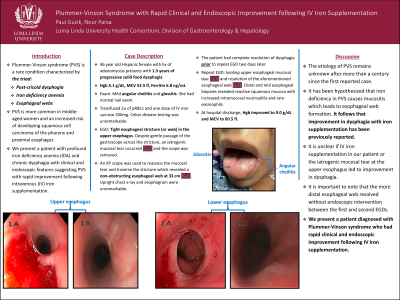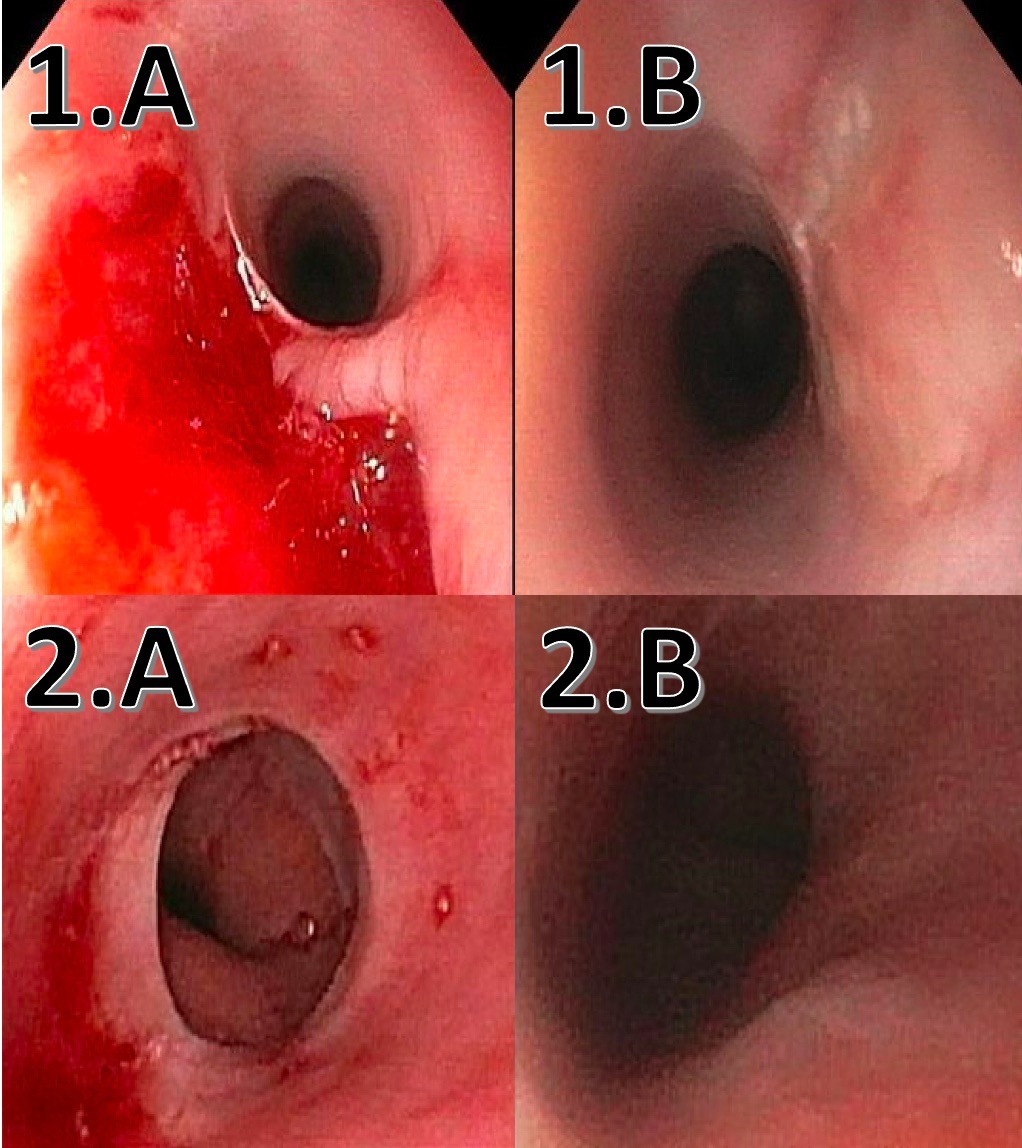Tuesday Poster Session
Category: Esophagus
P3298 - Plummer-Vinson Syndrome with Rapid Clinical and Endoscopic Improvement Following IV Iron Supplementation
Tuesday, October 24, 2023
10:30 AM - 4:00 PM PT
Location: Exhibit Hall

Has Audio

Paul Guzik, DO
Loma Linda University
Redlands, CA
Presenting Author(s)
Paul Guzik, DO1, Nour Parsa, MD2
1Loma Linda University, Redlands, CA; 2Loma Linda University Health, Loma Linda, CA
Introduction: Plummer-Vinson syndrome (PVS) is a rare condition characterized by the triad of post-cricoid dysphagia, iron deficiency anemia, and esophageal webs. PVS is more common in middle-aged women and is associated with an increased risk of developing squamous cell carcinoma of the pharynx and proximal esophagus.</span> We present a patient with profound iron deficiency anemia (IDA) and chronic dysphagia, displaying clinical and endoscopic features suggestive of PVS, with rapid improvement following intravenous (IV) iron supplementation.
Case Description/Methods: A 46 year old Hispanic female with history of adenomyosis presents with 1.5 years of solid food dysphagia. Initial labs revealed a hemoglobin (Hgb) 5.1 g/dL, MCV 52.5 fl, and ferritin of 6.8 ng/mL. Exam revealed mild angular cheilitis and glossitis, with normal nail exam. She was transfused two units packed red blood cells and 200mg IV iron sucrose. Celiac disease testing was unremarkable. Esophagogastroduodenoscopy (EGD) revealed a tight esophageal web in the upper esophagus (UE). Despite gentle passage of the gastroscope, an iatrogenic mucosal tear was noted and the scope was removed. An XP scope was used to reassess the mucosal tear and traverse the UE which revealed a second non-obstructing esophageal web at 33 cm from oral incisors. Upright chest x-ray and esophagram were unremarkable. The patient had resolution of dysphagia prior to repeat EGD two days later, which revealed the resolution of the UE mucosal tear and the aforementioned esophageal web. Esophageal biopsies revealed reactive squamous mucosa with intramucosal neutrophils and rare eosinophils. At hospital discharge, Hgb improved to 9.0 g/dL and MCV to 60.5 fl.
Discussion: The etiology of PVS remains unknown, even after more than a century since the first reported case. It has been hypothesized that iron deficiency in PVS contributes to mucositis, leading to the formation of esophageal webs. Previous reports have suggested that dysphagia can improve with iron supplementation. In our patient, it is uncertain whether the improvement in dysphagia was due to IV iron supplementation or the iatrogenic mucosal tear at the upper esophagus. Notably, the distal esophageal web resolved without endoscopic intervention between the initial and follow-up EGDs. This case highlights a patient diagnosed with Plummer-Vinson syndrome who experienced rapid clinical and endoscopic improvement following IV iron supplementation.

Disclosures:
Paul Guzik, DO1, Nour Parsa, MD2. P3298 - Plummer-Vinson Syndrome with Rapid Clinical and Endoscopic Improvement Following IV Iron Supplementation, ACG 2023 Annual Scientific Meeting Abstracts. Vancouver, BC, Canada: American College of Gastroenterology.
1Loma Linda University, Redlands, CA; 2Loma Linda University Health, Loma Linda, CA
Introduction: Plummer-Vinson syndrome (PVS) is a rare condition characterized by the triad of post-cricoid dysphagia, iron deficiency anemia, and esophageal webs. PVS is more common in middle-aged women and is associated with an increased risk of developing squamous cell carcinoma of the pharynx and proximal esophagus.</span> We present a patient with profound iron deficiency anemia (IDA) and chronic dysphagia, displaying clinical and endoscopic features suggestive of PVS, with rapid improvement following intravenous (IV) iron supplementation.
Case Description/Methods: A 46 year old Hispanic female with history of adenomyosis presents with 1.5 years of solid food dysphagia. Initial labs revealed a hemoglobin (Hgb) 5.1 g/dL, MCV 52.5 fl, and ferritin of 6.8 ng/mL. Exam revealed mild angular cheilitis and glossitis, with normal nail exam. She was transfused two units packed red blood cells and 200mg IV iron sucrose. Celiac disease testing was unremarkable. Esophagogastroduodenoscopy (EGD) revealed a tight esophageal web in the upper esophagus (UE). Despite gentle passage of the gastroscope, an iatrogenic mucosal tear was noted and the scope was removed. An XP scope was used to reassess the mucosal tear and traverse the UE which revealed a second non-obstructing esophageal web at 33 cm from oral incisors. Upright chest x-ray and esophagram were unremarkable. The patient had resolution of dysphagia prior to repeat EGD two days later, which revealed the resolution of the UE mucosal tear and the aforementioned esophageal web. Esophageal biopsies revealed reactive squamous mucosa with intramucosal neutrophils and rare eosinophils. At hospital discharge, Hgb improved to 9.0 g/dL and MCV to 60.5 fl.
Discussion: The etiology of PVS remains unknown, even after more than a century since the first reported case. It has been hypothesized that iron deficiency in PVS contributes to mucositis, leading to the formation of esophageal webs. Previous reports have suggested that dysphagia can improve with iron supplementation. In our patient, it is uncertain whether the improvement in dysphagia was due to IV iron supplementation or the iatrogenic mucosal tear at the upper esophagus. Notably, the distal esophageal web resolved without endoscopic intervention between the initial and follow-up EGDs. This case highlights a patient diagnosed with Plummer-Vinson syndrome who experienced rapid clinical and endoscopic improvement following IV iron supplementation.

Figure: 1.A Iatrogenic mucosal tear in upper esophagus due to esophageal web
1.B Healed mucosal tear in upper esophagus following IV PPI therapy (two days later)
2.A Nonobstructing esophageal web at 33cm from oral incisors
2.B Resolution of previously seen esophageal web following IV iron supplementation (two days later)
1.B Healed mucosal tear in upper esophagus following IV PPI therapy (two days later)
2.A Nonobstructing esophageal web at 33cm from oral incisors
2.B Resolution of previously seen esophageal web following IV iron supplementation (two days later)
Disclosures:
Paul Guzik indicated no relevant financial relationships.
Nour Parsa indicated no relevant financial relationships.
Paul Guzik, DO1, Nour Parsa, MD2. P3298 - Plummer-Vinson Syndrome with Rapid Clinical and Endoscopic Improvement Following IV Iron Supplementation, ACG 2023 Annual Scientific Meeting Abstracts. Vancouver, BC, Canada: American College of Gastroenterology.
